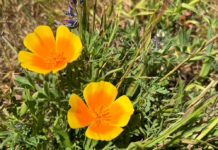It’s staggering how quickly the pages of the calendar require turning. I barely got familiar with the picture for September and now it’s gone. On to October. And, we all know what happens to the autumn months. They are confiscated by the fiends that force-feed us the frenzy of Christmas holiday giving and eating. But, we shall fight them. We shall concentrate on gardening, not shopping, for October is the best month of the year for planting.
So, we all know this is the time for separating perennials. Right? And it’s a great time for planting winter vegetables. Right? If you have cleared fields or cleared orchard floors, it’s time to plant a cover crop such as clover or bell beans. Right? Have a plan for a tulip garden in the spring? Put those bulbs in now. Right? Wrong.
Many bulbs need winterizing before they are planted. Here is what Google pulls up:
“Refrigerate tulips for about six weeks before planting. However, don’t put them near fruit or the ethylene gas will kill the buds that form the flowers. Place them in an area by themselves in the crisper drawer. However, do not freeze tulips or you will kill them.” — From Gardening Know How.
A whimsical, interesting source for gardening advice is the Farmers’ Almanac, still in print after all these years — at least I hope so? The Almanac provides guidance, even rules, based on the cycles of the moon, and the older I get the more I am a believer in that connection. An account of October reads as follows:
Oct. 6 through 10: A most barren period, best for killing plant pests or doing chores around the farm.
Oct. 11 and 12: Fine for sowing grains, hay, forage crops. Plant flowers. First day is favorable day for planting root crops. Second day is favorable for planting beans, peas, squash, sweet corn, tomatoes and other aboveground crops in Florida, Texas, California. (Really? Tomatoes? Maybe in Palm Springs.)
Oct. 13 through 15: Start seedbeds. Favorable days for planting aboveground crops, and leafy vegetables such as lettuce, cabbage, kale and celery where climate is suitable.
Oct. 16 and 17: Do clearing and plowing, but no planting.
Oct. 27 and 28: (We’ve skipped a bit) Good days for transplanting.
Nov. 1: Another good day for transplanting.
So, go for it. Dig up those perennials and slice them in two or three and replant.
Don’t be squeamish about cutting into a rootball, like a chrysanthemum. One old plant can yield a dozen new ones. Shasta daisies, Coreopsis, Sedum, they can all be divided. Ornamental grasses divide into as many plants as you want. And they grow as large as the mother plant in one season.
Check our local nurseries for wonderful winter color. There is always room for a wine barrel filled with primroses and pansies for your porch or doorway. Calendulas and cyclamen are better than poinsettias for Christmas and you can eat the calendulas instead of the fruitcake.
Even if you are only a gardener on the weekends, though your labor time is limited, you might kick your can of social obligations down the road until winter and devote some solid hours to working with the plants you have or add to them.
Those local nurseries will reveal a whole world of plant life that is just awakening while summer’s specialties are either over or going dormant. It’s pretty amazing how Mother Nature planned that. If you walk around you can imagine these winter lovers shouting, “Hurrah, hurrah. The hot days are over. We can jump up like Johnny!” See: Johnny Jump Ups, the smallest in the viola family.
One of the nicest gifts October gives are the free rains that help revive trees and plants and the fact that weed seeds are, for the most part, finished their race to overtake everything else in the garden. Stalwart and persistent, always battling Bermudagrass retreats and rests. Dig it up and rip it out as much as you can. It will return, like General MacArthur.
Equally important is the gardener. Take time to notice the work you and your fellow gardeners have accomplished. Take joy in caring for the life that is contained in the miracle within the world of plants and trees.
Yeah, October. Now we will see the true color of the leaves of Healdsburg’s trees and vines, when their green is gone.
Renee Kiff weeds and writes at her family farm in Alexander Valley.









